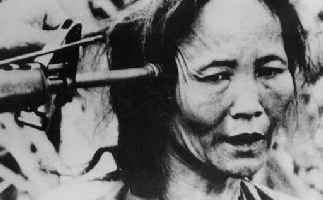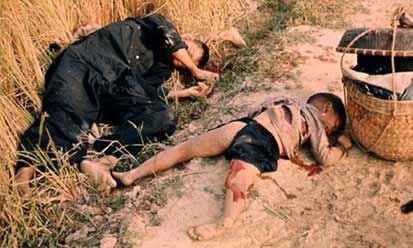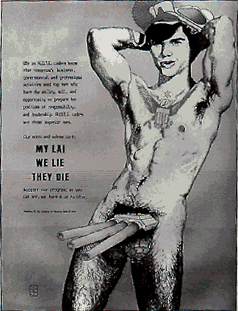|
My Lai Massacre The phrase "search and destroy" has taken on a sort of pop-culture currency in recent years, but in Vietnam circa 1968, it was anything but a glib cliche. It was an order, and lives could be resting on its successful execution.
The phrase "search and destroy" has taken on a sort of pop-culture currency in recent years, but in Vietnam circa 1968, it was anything but a glib cliche. It was an order, and lives could be resting on its successful execution.But when the order was issued outside a small village in Southern Vietnam widely called "My Lai" (its actual name is "Son My") on March 16, 1968, the result was a lot of "destroy" and very little "search." The resulting massacres represents one of the low points in American history, right up there with George Washington giving smallpox infected blankets to the natives (except more homicidal than genocidal). The Vietnam War had been going, well, not pleasantly, even relative to the way war generally tends to go. After a particularly heated and dangerous couple of weeks, the soldiers of Charlie Company came upon My Lai. Charlie Company had taken casualties, and the unit was known for its violent tactics. Two platoons went into My Lai looking for Viet Cong fighters, on the orders of Lt. William Calley. According to various accounts, the soldiers were given decidedly mixed messages about what to expect. Court martial testimony from one officer indicated that the soldiers had been told all the people in the village were VC soldiers or sympathizers, and that civilians had left the town. While the exact circumstances leading up to the attack are still argued about, what's undisputed is the outcome of the military maneuver. When they entered the village, the soldiers began shooting unarmed civilians. Orders were given to raze the huts the villagers lived in.
Men, women and children, including babies, were killed in the carnage that followed. Praying children were shot in the back of the head, elderly men were hacked to death with bayonets. People were shot on their knees, in the back, with their hands in the air. Not everyone in the company took part in the massacre, but enough of them did, led by Calley who reportedly mowed down 60 captured civilians in a ditch by himself after his soldiers balked at the order. Although the Army's official report determined that only about 10 soldiers actually performed the massacre, that's kind of hard to believe in light of the devastation ultimately wrought. More than 500 people were killed in just hours. Some of the corpses were mutilated. Some women who weren't killed were gang-raped. Other villagers were beaten and tortured. And evidence of the carnage was recorded on film by an Army photographer accompanying the unit named Ron Haeberle. Toward the end of the massacre, a helicopter gunship came to the assistance of the villagers. An army pilot named Hugh Thompson landed his craft in between villagers and the rampaging soldiers, ordering his gunner, Lawrence Colburn to fire on any soldier who continued pursuing the fleeing villagers. Thompson and Colburn radioed two more helicopters to the scene and airlifted a dozen villagers to safety. They were rewarded for their bravery... thirty years later. The helicopter's crew chief Glenn Andreotta was also recognized for bravery, but posthumously. Before the war ended, he became one more casualty of Vietnam. In the aftermath of the massacre, the soldiers on the scene made an effort to cover up the killings, minimizing the number of civilian casualties to a couple dozen, a claim which was repeated in several subsequent official reports. And that would likely have been the end of it, except for a former GI named Ron Ridenhour, who practiced the lost art of writing to his congressman, after hearing ominous tales of a terrible massacre from his fellow soldiers:
"I asked 'Butch' several times if all the people were killed. He said that he thought they were men, women and children. He recalled seeing a small boy, about three or four years old, standing by the trail with a gunshot wound in one arm. The boy was clutching his wounded arm with his other hand, while blood trickled between his fingers. He was staring around himself in shock and disbelief at what he saw. 'He just stood there with big eyes staring around like he didn't understand; he didn't believe what was happening. Then the captain's RTO (radio operator) put a burst of 16 (M-16 rifle) fire into him.' It was so bad, Gruver said, that one of the men in his squad shot himself in the foot in order to be medivaced out of the area so that he would not have to participate in the slaughter. Although he had not seen it, Gruver had been told by people he considered trustworthy that one of the company's officers, 2nd Lieutenant Kally (this spelling may be incorrect) had rounded up several groups of villagers (each group consisting of a minimum of 20 persons of both sexes and all ages). According to the story, Kally then machine-gunned each group. Gruver estimated that the population of the village had been 300 to 400 people and that very few, if any, escaped. (...)The letter was also sent to Gen. William Westmoreland, who was in charge of the Vietnam theater. Incredulous at the charge, Westmoreland ordered an investigation. Unfortunately for his credulity, the evidence supported the stories. Calley was ordered back the U.S. and subsequently charged with 109 counts of murder, an appalling number but well below the real death toll.
The Army, already under intense pressure for its conduct in Vietnam, didn't care for those numbers. Barely a quarter of those would see trial. Only one man was convicted for his actions at My Lai, the unit's commander, William Calley. He was sentenced to life in prison with hard labor, but the great humanitarian, Richard M. Nixon, granted Calley a lot more mercy that the lieutenant had granted the villagers of My Lai, and commuted the sentence. The images and the story of My Lai represented a major turning point in public attitudes toward Vietnam. In addition to their horror at the actual massacre, the handling of the prosecutions revolted Americans from nearly every part of the political spectrum. Not only did Calley serve as the scapegoat for the actions of his unit, but his punishment didn't even remotely fit the magnitude of the crime. The Army tried to downplay the event, continuing to underestimate the casualties and the violence for years afterward. The American government refused to acknowledge the event in diplomatic exchanges. It took 30 years for the few soldiers who defended innocent lives to get medals from Congress, and even then, infighting among the Army brass made the process of recognizing Thompson and Colburn torturous, long after the U.S. had gotten the hell out of Vietnam. There were so many horrors concerning the events at My Lai and the actions of the military in its aftermath, it was hard for most people to figure out where to start raging. Or when to stop. If ever.

Timeline
|
 Even with the ultraviolent and paranoid atmosphere of combat in Vietnam, one would think that after killing a couple dozen unarmed civilians with no resistance, the company might have stopped to re-evaluate its strategy of killing everyone that moved. Didn't happen.
Even with the ultraviolent and paranoid atmosphere of combat in Vietnam, one would think that after killing a couple dozen unarmed civilians with no resistance, the company might have stopped to re-evaluate its strategy of killing everyone that moved. Didn't happen. 
 Toward the end of 1969, investigative journalist Seymour Hersh broke the story in the public realm. A groundswell of horror rose in the American public, which had already wearied of the war. Hundreds of witnesses were called. The charges included murder, rape, sodomy and mayhem. The original investigators recommended 30 prosecutions for the atrocities and 30 more for the cover-up.
Toward the end of 1969, investigative journalist Seymour Hersh broke the story in the public realm. A groundswell of horror rose in the American public, which had already wearied of the war. Hundreds of witnesses were called. The charges included murder, rape, sodomy and mayhem. The original investigators recommended 30 prosecutions for the atrocities and 30 more for the cover-up.